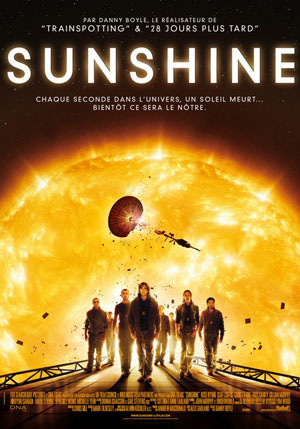- Title: Sunshine
- IMDb: link

“Our sun is dying. Mankind faces extinction. Seven years ago the Icarus project sent a mission to restart the sun but that mission was lost before it reached the star. Sixteen months ago, I, Robert Capa, and a crew of seven left Earth frozen in a solar winter. Our payload, a stellar bomb with a mass equalivant to Manhattan Island; our purpose, to create a star within a star.”

50 years into the future our sun is dying. One mission to restart the star has already failed; now the fate of the world and the entire human race rests in the hands of the crew of the Icarus II who will attempt a desperate mission to try and re-ignite the sun using all of the world’s remaining nuclear weapons. It’s an interesting set-up as we begin with the crew already 50,000,000 miles away from Earth when the discovery of the first Icarus spacecraft and a small miscalculation put the lives of the crew, and the entire population of Earth, in jeopardy.
The crew of the Icarus II consists of the captain (Hiroyuki Sanada), the biologist (Michelle Yeoh), the psychologist (Cliff Curtis), the bomb expert (Cilian Murphy), the emotional female (Rose Byrne) whose role on the ship, other than being one of the crew’s girlfriend, isn’t well defined, the navigator (Benedict Wong), the hot-shot tough guy (Chris Evans), and the communications expert (Troy Garity).
One of the film’s flaws is that it fails to provide useful background information that would be helpful. We aren’t given any information about the crew, their pasts, or how they were chosen for this mission. Nor, and more troubling, is neither the ship’s layout nor many of its functions are explained or explored. All of the action in the film takes place in this series of metal tubes yet we are never given an idea of how it fits together. Events happen here or there on the ship, but no one seemed to figure out how the ship actually fits together and where these separate compartments fit into the overall scheme. This becomes both distracting and at times confusing. When there is a hull breach or fire, which parts of the ship are in jeopardy? Which might be closed off? We can’t tell because no one has bothered to let us in on where anything on the ship is located.
More troubling than this however is the final third of the film. The set-up works well enough and the characters seem to deal naturally with the issues and problems that arise. Then, out of nowhere, the film strops behaving like a science fiction film and quickly turns into a thriller/monster flick. I won’t give away how or why this happens (both disappointing in themselves) but just state that the effect of this genre shift is felt in all aspects of the film. The tone shifts drastically as the intelligent struggle of the early film is lost in the mindless chases and gore of the final scenes. And the beautiful look of the film, the wide sweeping majestic shots of the ship and of space, disappears in favor of steady cam, blurry special effects, odd lighting, and quick-cuts that make you wonder when you stepped out of the movie theater and got on this unscheduled roller-coaster ride. What’s so troubling is this odd change isn’t necessary; in the first two-thirds of the film character conflicts and real problems provide enough suspense to keep you invested much more than these late antics could ever wish to achieve.
Is it as good as recent doomsday flicks such as The Day After Tomorrow, The Core, or even Armageddon? No, but it provides some nice visuals and, for two-thirds of its running time, a compelling story. Early comparisons to films like 2001: A Space Odyssey or last year’s The Fountain (read that review) are going to raise expectations far too high for a film like this to measure up. But if you are a sci-fi fan and you can overlook a pretty disappointing final act and focus on the positvies of the film you should have a reasonably good time.
